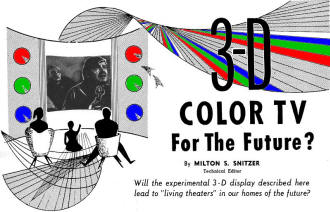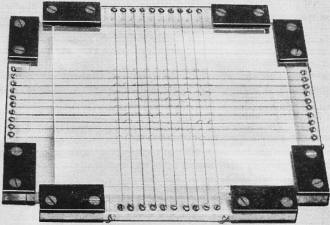|
You can add to the long list of
technical wonders promised - and not delivered - to us by the end of the twentieth
century (this is now the 21st century, btw) a three-dimensional (3D) television
set. This 1958 article from Radio & TV News magazine described efforts
already made by the movie industry for generating 3D films that provided audiences
with life-like projections that were designed to shock their senses by having scary
or dangerous objects suddenly hurled at them. Pictures of a theater filled with
people wearing the cardboard-framed red/blue
stereoscopic glasses are a very familiar symbol of the scheme
known as stereoscopy.
Another method of 3D image perception was to use horizontal and vertical polarization
along with appropriately configured glasses to separate the images entering the
eyes and relying on the brain to convert a pair of two-dimensional pictures into
a three-dimensional image. Designers who came up with the
ViewMaster line of viewers used a different approach that used
two cameras separated by some distance to record a unique perspective of the same
scene and presenting the two images to the viewer's eyes. It was the most life-like
scheme and, unlike the other described schemes, could be made in full color. This
article reported on an electronic display that promised to generate holographic-like
renditions of scenes by creating the actual picture in three dimensions - no hokey
glasses or viewers required. Although distinctly different from the semiconductor-
or plasma-derived displays, it fundamentally is similar because of the way an x-y
matrix of signals energize each specific electro-fluorescent location on the screen
rather than employing a steered electron stream.
3-D Color TV for the Future?
 By Milton S. Snitzer, Technical Editor By Milton S. Snitzer, Technical Editor
Will the experimental 3-D display described here lead to "living theaters" in
our homes of the future?
What will our TV sets of the future be like? Surely we should not have to keep
our eyes glued to a rather small flat screen with tiny flat figures on it. Just
imagine what depth and realism could come from a large three-dimensional colored
image - just like a real-life play right in our own living rooms. This would not
be an optical illusion but real 3-D.
Some 3-D Methods
The movie industry has experimented with two methods that can give the illusion
of depth. In one, two differently colored images are superimposed on the flat screen.
If the viewer then sees these through special glasses whose lenses match the colors
of the images, he will see one image with one eye and another image with the other
eye. The two separate pictures are combined in the mind of the viewer to produce
a 3-D picture.

Experimental unit made up of two sets of wire electrodes at right
angles to each other supported and insulated on a glass plate. Tiny holes at the
intersections of the wires are filled with a transparent electroflor and the assembly
is sealed. The electroflor will fluoresce and give off light of various colors when
electrically stimulated. Any number of these flat plates may be stacked together
to produce a true 3-D display device.
Another idea is to project one image with light that is polarized in one direction,
and project the other image with light polarized in another direction. Again, special
glasses made up of polarized light filters could be used to produce the two separate
pictures needed for 3-D. With this second method, full-color pictures can be given
depth and realism.
Recently, General Electric has developed the world's first 3-D color television
system for remote servicing of nuclear reactors. This system is strictly a closed-circuit
setup that is not currently feasible for the living room. The technician who will
view the picture will use special polarizing glasses like those used for 3-D movies.
But what about producing a picture that has true depth and does not require special
glasses or other illusion techniques? The 3-D display device to be described may
provide the answer.
3-D Electroflor
Electroflors are certain new materials that can store electrical energy. When
an indicating material is added, the combination will give off light if electrically
stimulated by fairly low voltages. Normally the material is crystal-clear. About
50 electroflors are available from such companies as Shannon Luminous Materials
Co., Hollywood, California with a variety of colors and storage times.
In practice, a flat glass or plastic plate with a series of tiny holes may be
used. A gridwork of fine wires criss-cross each hole, which is filled with the electroflor
and sealed. The leads can also be evaporated metal coatings, thin enough to remain
transparent. With 500 leads on a side and a 25-inch square, definition about equal
to a conventional TV picture tube may be had. The plates may be made as large as
needed.
By the use of 3 thin plates sandwiched together, each of which glows with a primary
color, it is possible to produce a full-color display. Then by stacking a number
of such plates together to any desired thickness a true 3-D display is produced.
Experimental versions of such displays have already been made. Of course special
scanning signals would have to be used to produce a TV-like raster.
Perhaps after we have added color and depth to our TV of the future, we may want
to make the display even more real by adding odors. Can't you smell that sizzling
steak now?
Color and Monochrome (B&W) Television
Articles
Posted September 20, 2023
(updated from original post on 12/26/2019)
|












